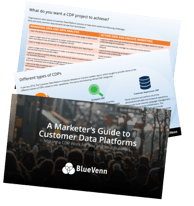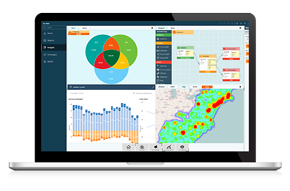 Keeping things tidy, unified and in one place… is this your customer data? Or your sock drawer?
Keeping things tidy, unified and in one place… is this your customer data? Or your sock drawer?
During the holiday season, just as retailers expect to see a surge in shopping activity and customer data, many of us expect a wave of socks to engulf us as we open our stockings. Even the most organized people struggle to keep their sock collections in order at this time of year. On an average day, most people will have one in the sock drawer, one in the dryer, several pairs accidentally put into little Jimmy’s room, and more languishing on the radiator. With no system in place to ensure they’re correctly matched, assigned to the right person, and easy to find at a moment’s notice when needed, it’s anarchy. And with new Christmas socks set to be added any day now, the situation is only going to get worse!
Why is this Customer Data Platform company talking about socks, you might be thinking? Well, because a messy sock drawer is not too dissimilar to the state of many retailers’ customer data stores. Disparate data from ERPs, eCommerce platforms, POSs, email software, loyalty systems and other marketing platforms is often left siloed around the business, with customer records being imperfectly linked. This Christmas, of all Christmases, a jumbled mess of data won’t cut it. Why? Because this year, having a complete, well ordered view of each customer's journey will be more important than ever.
A tough market for retailers
A recent Retail Study conducted by BlueVenn found that, in the wake of the pandemic, 55% of consumers say that they will dramatically change the way they do their festive shopping, with 45% predicting that this seasonal behavior to be indicative of their shopping habits in 2021.
One might assume that the health risks would lead customers to forgo in-store shopping altogether, and indeed we found that the proportion of customers planning to do more than 50% of their shopping online has grown from 22% in 2019 to 49% in 2020, while the percentage of shoppers planning to do over 50% of their shopping in-store has dropped from 54% last year to 21% this year. But 53% of consumers still plan to buy their gifts through a mix of online and in-store shopping, with a wish to foster Christmas spirit and the need to take a break from rigid regulations being cited as the top reasons for doing so.
That being the case, retailers whose databases resemble a disorganized sock drawer, with bits and pieces all over the place, mismatches, duplicates and holes in their data, will find it an uphill struggle trying to stay abreast of retailers’ changing habits in order to make sales. There simply will not be as much money to go around this year (and probably next). After all, despite the fact that 44% of consumers expect to spend more per shopping trip this year, compared with 20% expecting to spend less, the number of trips is likely to go down and 45% of shoppers expect to spend less overall.
Retail Study: The changes in consumer shopping behavior for Christmas 2020 and beyond

Making the most of available customer data
So, just as keeping the sock drawer tidy has taken on a new importance for the many workers spending most of their time at home and not wishing to be surrounded by chaos, ensuring your customer data store is fit-for-purpose, functional and easy to navigate this season will be important to those retailers hoping to make up some of this year’s deficits by drawing a hefty share of the potential revenue on offer.
Specifically, they will need to understand:
 Which of their valued in-store customers have moved online.
Which of their valued in-store customers have moved online.- Which, now that the regulations are easing in some areas, are becoming the new normal, the ‘hybrid shopper’, darting back and forth between the shops and the website at the drop of a hat.
- Which customers are a little more wary and, now that they have made the jump online, are content to stay there for the foreseeable future.
Our research shows that many retailers are struggling to construct the Single Customer View needed to understand every interaction a customer has with their business, and they’re worried. In fact, 57% fear they may not able to adjust to changing consumer behavior fast enough, while 62% anticipate losing customers to competing online retailers. Considering 54% of them report that they don’t track the customer journey both online and in-store, while 41% aren’t even tracking multichannel spend, this isn’t surprising. The socks are scattered all over the place, and their collection is a mess.
So, what’s the answer to taking back control? Let’s think first about what would be involved in taming that troublesome sock drawer.
- Sock identity management: Identify every siloed sock and unify them all in one place, such as the dining table. Resolve the identity of each sock by looking carefully for indicators that they match another (sometimes socks can look the same, but aren’t really, with differences like band width and length disclosing a mismatch). So, make sure you have a rigorous identity resolution strategy in place to stop mistakes from creeping in.
- Sock unification: When pairing like socks, it is important to check for sock quality as well. Are there any holes or thin spots that need to be addressed before unifying a pair of socks? If so, you’ll be likely to receive complaints from the user (or wearer) further down the line if these aren't fixed!
- Sock automation: As you receive those spangly new Christmas socks, or different pairs go through the wash, make sure you put a clear strategy in place to maintain your clean, unified sock drawer, to ensure you never get into such a jumble again.
In data terms, this means:
- Customer identity management: Use a Customer Data Platform with identity resolution tools to link and match customer records across many siloed systems. A CDP that provides data cleansing and enhancements natively is key here, to ensure that, as with sock markings, you can use trustworthy indicators to determine when to join two records together and when not to. This will give you the foundations of a Single Sock View (sorry, I mean a Single Customer View)!
- Customer data unification: Having resolved the identity of each customer, you will then need to unify all behaviors and transactions with each Golden Record, so that you will have access to each customer’s gathered personal data and brand interactions. Removing any holes in your data through data enhancements provided within the CDP itself, including normalizing, cleansing and de-duplicating the information using customizable matching rules, will make for a more accurate matching process.
- Customer data automation: Ensure you will be able to gain insights from your customer data by selecting a CDP that has analysis tools that won’t call for you to write any complex codes or data queries. After all, we’re not all sock scientists (erm, I mean data scientists), so look for easy-to-use, visual platforms, built for the use of marketers, which also offer the flexibility to delve deep into the data, then activate it in an automated way through inbound and outbound marketing channels.
A Marketer’s Guide to Customer Data Platforms eBook

Addressing the scale of the sock drawer issue
Of course, taking care of your own socks isn’t all that difficult really, and even if you had charge of a boarding house of 20 kids and needed to monitor all of their socks, that would be entirely doable. But think of being in charge of all the socks for a school of 600 kids. Or a village of a couple of thousand. Or a city of 100,000. Or a small country of 1 million. You’d be buried under a mountain of socks, constantly erupting with a flood of even more socks!
Just as managing that many socks would take a huge amount of time, resources and commitment, managing your data will take work and expertise. One solution might be to hire a data consultant, capable of building rules and schema to help you to manage your data, now and in the future (this is a bit like paying a specialist to set up a sock management system for you to use going forward).
Alternatively, a CDP will go a long way towards helping you to not only gain control of your data, but harness its full benefits. A recent Omnichannel Marketing Excellence study, run by BlueVenn and London Research, found that CDP users are twice as likely to have fully synchronized, tailored cross-channel communications, three times as likely to personalize their website and ecommerce store, using both offline and digital consumer variables, and five times as likely to be using real-time or time-based triggered messaging and personalization as non-CDP users. They are also over twice as likely to significantly outperform their marketing goals.
Essentially, it’s like having your own, fully automated sock-sorting management factory, which sits at the heart of your operation, and around which all the sock service sales, communications with owners, sock-tidy promotions and everything else will run. In the same way, the marketing stack is powered by the CDP, with all data feeding into it, and if your CDP has an omnichannel marketing hub attached to it, all campaigns will be powered by the insights that it produces. You’ll be a sock mogul in no time (or any sort of mogul you want to be, really)!
Being able to understand your customers and personalize your brand journey will be a huge boost at a time when the retail world is struggling, customers are shopping on more channels than ever before, and every store and online seller is fighting to capture those precious Christmas dollars. To find out more about managing a thriving sock empire – sorry, I mean, about how the BlueVenn Marketing Hub can harness your data to give your business a much needed boost – book a demo here. Or, to find out more about how consumer festive shopping habits are changing and retailers are keeping up with them in 2020 and beyond, read our Retail Study now.
Register for the next live demonstration of the BlueVenn Customer Data Platform & omnichannel marketing hub
Join us at
 , when we will cover:
, when we will cover:
- Unifying data to create a Single Customer View.
- Improving customer intelligence with data analytics.
- Using machine learning and Next Best Action.
- Segmentation and RFM modeling.
- Omnichannel customer journey optimization.
- Multi-touch attribution.












